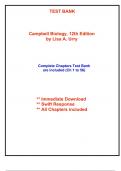TEST BANK
Campbell Biology, 12th Edition
by Lisa A. Urry
Complete Chapters Test Bank
are included (Ch 1 to 56)
** Immediate Download
** Swift Response
** All Chapters included
,Table of Contents are given below
1.Evolution, the Themes of Biology, and Scientific Inquiry
2.The Chemical Context of Life
3.Water and Life
4.Carbon and the Molecular Diversity of Life
5.The Structure and Function of Large Biological Molecules
6.A Tour of the Cell
7.Membrane Structure and Function
8.An Introduction to Metabolism
9.Cellular Respiration and Fermentation
10.Photosynthesis
11.Cell Communication
12.The Cell Cycle
13.Meiosis and Sexual Life Cycles
14.Mendel and the Gene Idea
15.The Chromosomal Basis of Inheritance
16.The Molecular Basis of Inheritance
17.Gene Expression: From Gene to Protein
18.Regulation of Gene Expression
19.Viruses
20.DNA Tools and Biotechnology
21.Genomes and Their Evolution
22.Descent with Modification: A Darwinian View of Life
23.The Evolution of Populations
24.The Origin of Species
25.The History of Life on Earth
26.Phylogeny and the Tree of Life
27.Bacteria and Archaea
28.Protists
29.Plant Diversity I: How Plants Colonized Land
30.Plant Diversity II: The Evolution of Seed Plants
31.Fungi
32.An Overview of Animal Diversity
33.An Introduction to Invertebrates
34.The Origin and Evolution of Vertebrates
35.Vascular Plant Structure, Growth, and Development
36.Resource Acquisition and Transport in Vascular Plants
37.Soil and Plant Nutrition
38.Angiosperm Reproduction and Biotechnology
39.Plant Responses to Internal and External Signals
40.Basic Principles of Animal Form and Function
41.Animal Nutrition
42.Circulation and Gas Exchange
43.The Immune System
44.Osmoregulation and Excretion
45.Hormones and the Endocrine System
46.Animal Reproduction
47.Animal Development
48.Neurons, Synapses, and Signaling
49.Nervous Systems
50.Sensory and Motor Mechanisms
51.Animal Behavior
52.An Introduction to Ecology and the Biosphere
53.Population Ecology
54.Community Ecology
55.Ecosystems and Restoration Ecology
56.Conservation Biology and Global Change
,The test bank is organized in reverse order, with the last chapter displayed first, to ensure that all
chapters are included in this document. (Complete Chapters included Ch56-1)
Campbell Biology, 12e (Urry)
Chapter 56 Conservation Biology and Global Change
56.1 Multiple Choice Questions
1) Philippe Bouchet and colleagues conducted a massive survey of marine molluscs on the west
coast of New Caledonia. For 20% of the total species that were located and identified, only a
single specimen was found. Which of the following claims about the diversity of molluscs in this
area is best supported by the evidence?
A) The west coast of New Caledonia is not an appropriate habitat for molluscs.
B) Many of the species from this 20% are probably rare.
C) They were not sampling uniformly throughout the area.
D) Many of the species from this 20% are most likely just dispersing through the area.
Answer: B
Topic: Human activities threaten Earth's biodiversity
Bloom's Taxonomy: Levels 3-4: Applying/Analyzing
Learning Outcome: 56.1, Global LO: G2, V&C LO: VC-S
2) If all individuals in the last remaining population of a particular frog species were all highly
related, which type of diversity would be of greatest concern when planning to prevent the
species from going extinct?
A) global diversity
B) local diversity
C) ecosystem diversity
D) genetic diversity
Answer: D
Topic: Human activities threaten Earth's biodiversity
Bloom's Taxonomy: Levels 1-2: Remembering/Understanding
Learning Outcome: 56.1, Global LO: G1, V&C LO: VC-S
3) Which of the following best describes the biological significance of genetic diversity between
populations?
A) Genes for traits conferring an advantage to local conditions are unlikely.
B) The population that is most fit would survive by competitive exclusion.
C) Genetic diversity reduces the probability of extinction.
D) Diseases and parasites are not spread between separated populations.
Answer: C
Topic: Human activities threaten Earth's biodiversity
Bloom's Taxonomy: Levels 3-4: Applying/Analyzing
Learning Outcome: 56.1, Global LO: G2, V&C LO: VC-S
1
, 4) Tropical forests are being converted to farm or pasture land at an alarming rate. The impact of
the deforestation on the biodiversity of the ecosystem is a major focus of research and
conservation efforts. Which of the following is a direct benefit to humans that best explains why
these forests need to be preserved?
A) Biodiversity in the tropics increases the potential to store more carbon from the atmosphere.
B) Natural and undisturbed areas are important wildlife habitats.
C) The diversity could contain novel medications for consumers.
D) The plant diversity provides unique areas for ecotourism.
Answer: C
Topic: Human activities threaten Earth's biodiversity
Bloom's Taxonomy: Levels 3-4: Applying/Analyzing
Learning Outcome: 56.1, Global LO: G2, V&C LO: VC-S
5) Which of the following is an ecosystem service that includes processes that increase the
quality of the abiotic environment?
A) Keystone predators have a marked effect on species diversity.
B) Green plants and phytoplankton produce the oxygen we breathe.
C) Bees, flies, and wasps pollinate many plants.
D) The presence of dams improves flood control.
Answer: B
Topic: Human activities threaten Earth's biodiversity
Bloom's Taxonomy: Levels 1-2: Remembering/Understanding
Learning Outcome: 56.1, Global LO: G1, V&C LO: VC-S
6) Erwin and Scott used an insecticidal spray to remove insects from the top section of an L.
seemannii tree and collect them from the forest floor. Using the data collected, Erwin projected
that this entire tree, from top to bottom, is host to about 600 unique arthropod species, which
were not found on any other tree species. While the researchers also identified 900 beetle species
from the top section, the vast majority of them were known to be found on many other tree
species. If there are approximately 50,000 species of tropical trees, and assuming that every tree
hosts a similar number of unique species, which of the following would be the best quantitative
method to roughly estimate the total number of arthropod species, globally?
A) Estimate the species density and then multiply by 50,000.
B) Multiply 600 by 50,000.
C) Multiply 50,000 by 900.
D) Add 900 to 600, and then multiply by 50,000.
Answer: B
Topic: Human activities threaten Earth's biodiversity
Bloom's Taxonomy: Levels 3-4: Applying/Analyzing
Learning Outcome: 56.1, Global LO: G2, V&C LO: VC-S
2




